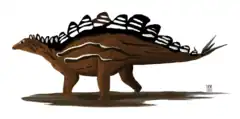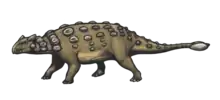| Gobisaurus Temporal range: Late Cretaceous, | |
|---|---|
 | |
| Restoration of G. domoculus | |
| Scientific classification | |
| Domain: | Eukaryota |
| Kingdom: | Animalia |
| Phylum: | Chordata |
| Clade: | Dinosauria |
| Clade: | †Ornithischia |
| Clade: | †Thyreophora |
| Suborder: | †Ankylosauria |
| Family: | †Ankylosauridae |
| Genus: | †Gobisaurus Vickaryous et al., 2001 |
| Species: | †G. domoculus |
| Binomial name | |
| †Gobisaurus domoculus Vickaryous et al., 2001 | |
| Synonyms | |
| |
Gobisaurus is an extinct genus of herbivorous basal ankylosaurid ankylosaur from the Upper Cretaceous (and possibly also the Lower Cretaceous) of China (Nei Mongol Zizhiqu). The genus is monotypic, containing only the species Gobisaurus domoculus.[1]
Discovery and naming
The Sino-Soviet Expeditions (1959–1960) discovered an ankylosaurian skeleton in the Gobi Desert of Inner Mongolia near Moartu, in the region of the Alashan Desert. The find was largely neglected until fossils were selected for a travelling exhibition touring the globe between 1990 and 1997, in the context of the China-Canada Dinosaur Project. The postcranial skeleton could not be located but the skull was displayed, informally labelled "Gobisaurus", at the time a nomen nudum.
In 2001, Matthew K. Vickaryous, Anthony P. Russell, Philip John Currie and Zhao Xijin named and described the type species Gobisaurus domoculus. The generic name means "Gobi (Desert) lizard," referring to its provenance. The specific name means "hidden from view" in Latin, referring to its being overlooked for three decades.[2]
The holotype, IVPP V12563, was found in a layer of the Ulansuhai Formation. In 2001, an Aptian age was presumed but later studies indicate it dated from the younger Turonian. It consists of a skull and the as yet undescribed postcranial remains.[2]
In 2014, Victoria Arbour concluded that Zhongyuansaurus, the type specimen of which, HGM 41HIII-0002, includes extensive postcranial remains, was a possible junior synonym of Gobisaurus.[3]
Description

Gobisaurus is a large ankylosaurian. The skull measured 46 centimetres (18 in) in length and 45 centimetres (18 in) across.[1]
Gobisaurus domoculus shares many cranial similarities with Shamosaurus scutatus, including a rounded squamosal, short squamosal horns, low supraorbital bosses, large elliptical orbital fenestrae and external nares (oval eye sockets and nostrils), the cross-section of the eye sockets being about a fifth of skull length, a deltoid dorsal profile with a narrow rostrum (a narrow, kite-shaped, snout in top view), quadratojugal protuberances (cheek horns), and caudolaterally directed paroccipital processes (extensions of the rear skull pointing to behind and sideways). But the two taxa may be distinguished by differences in the length of the maxillary tooth row (26,6% instead of 40% of total skull length with Gobisaurus), an unfused basipterygoid-pterygoid process in Gobisaurus, the front of the pterygoid being in e vertical position, the presence on an elongate vomerine premaxillary process in Gobisaurus, and the presence of cranial sculpting in Shamosaurus, but not in Gobisaurus.[2][1] This latter difference was denied by Arbour who concluded that the degree of sculpting was roughly the same.[3]
The external nostrils had about 23% of skull length.[2]
Phylogeny
Gobisaurus was placed in the Ankylosauridae in 2001.[2] Vickaryous et al., 2004 found that a clade formed by Shamosaurus and Gobisaurus is "nested deep within the ankylosaurid lineage as the first successive outgroup to (the subfamily) Ankylosaurinae".[1]
Other analyses find a more basal position as the sister species of Shamosaurus. Concluding that Zhongyuansaurus was a probable junior synonym of Gobisaurus, Arbour considered it unnecessary to use the term Shamosaurinae for the clade including just Shamosaurus and Gobisaurus.[3]
See also
References
- 1 2 3 4 Vickaryous M.K., Maryańska T., Weishampel D.B., 2004, "Ankylosauria". Chapter 17 in: Weishampel D.B., Dodson P., Osmólska H., editors. The Dinosauria. 2nd ed. Berkeley (CA): University of California Press. p. 363–392
- 1 2 3 4 5 Matthew K. Vickaryous, Anthony P. Russell, Philip J. Currie, and Xi-Jin Zhao. 2001. "A new ankylosaurid (Dinosauria: Ankylosauria) from the Lower Cretaceous of China, with comments on ankylosaurian relationships". Canadian Journal of Earth Sciences/Revue canadienne des sciences de la Terre 38(12): 1767-1780 http://www.nrcresearchpress.com/doi/pdf/10.1139/e01-051
- 1 2 3 Arbour, Victoria Megan, 2014. Systematics, evolution, and biogeography of the ankylosaurid dinosaurs. Ph.D thesis, University of Alberta

